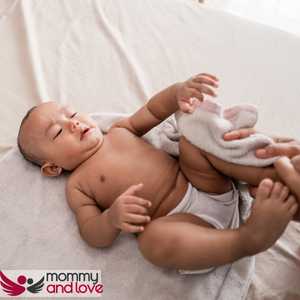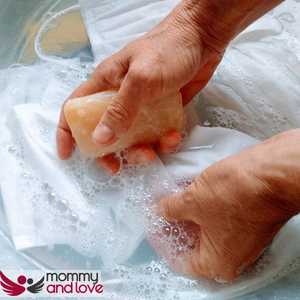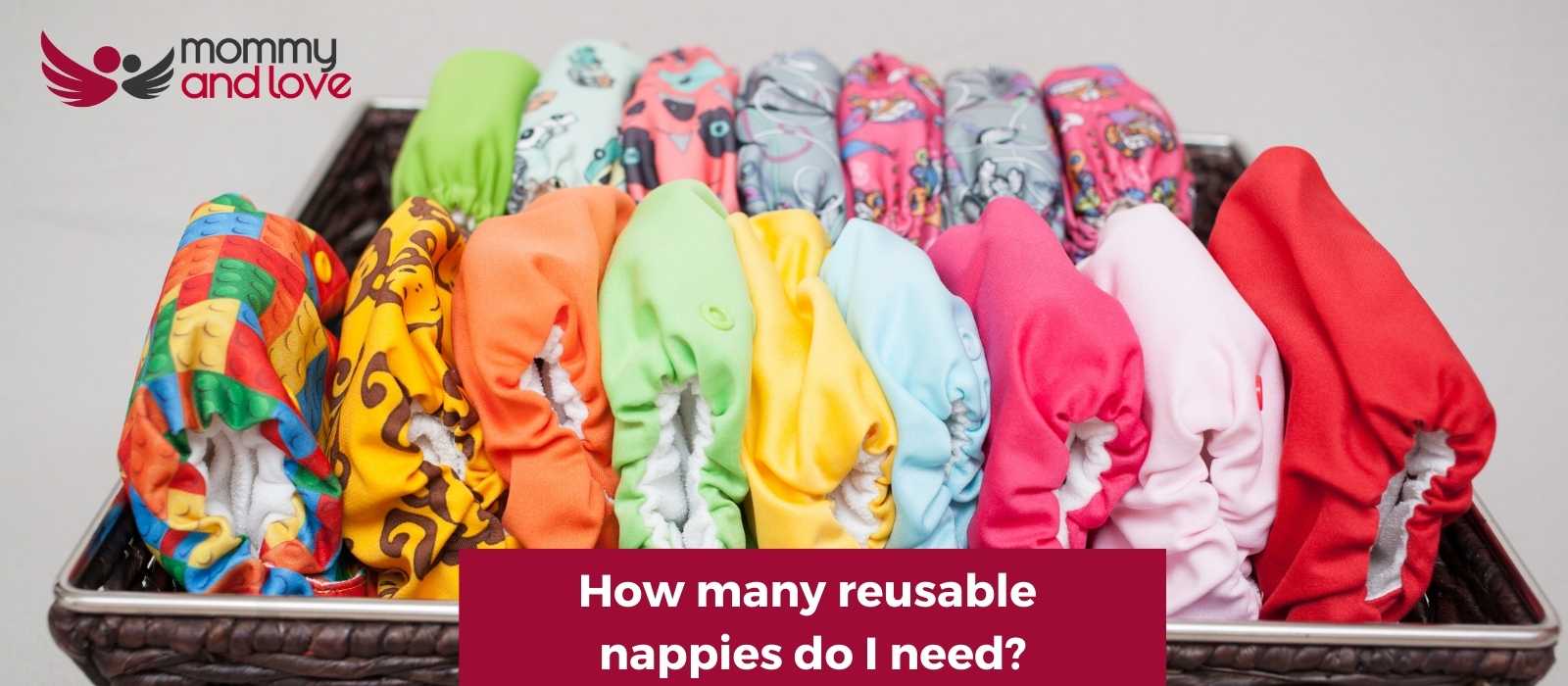Unlike disposable nappies which you can buy weekly, you need to buy your reusable nappies upfront and therefore you need to work out how many nappies you need. It’s a big investment and whilst the birth to potty nappies will last you until they are potty trained, you do need to consider what will last you on your cloth nappy journey.
Overall, as a very rough rule of thumb, we recommend 25 nappies for full-time use from birth. However, this really varies depending on your child’s age, how often they do bowel movements, what type of nappies you have, how often you plan to wash, and your drying facilities.
We will go through each of these in detail below but in most cases these days, people use between 6-10 cloth nappies per day. So for full-time use, washing every 2 days, we recommend 20-25 reusable nappies as a very general rule of thumb.

How many cloth nappies do I need for my newborn baby?
A newborn baby needs at least 24 cloth nappies, more if they are having several bowel movements per day or extra feeds. This is because the nappy will get quite wet between changes and should be changed before it is too wet.
A newborn child can use up to 12 nappies daily. The average baby will have about four or five bowel movements a day for the first few weeks. This number reduces quickly to an average of three, then two and finally one from around six months old.
How many 2 part nappies do I need?
If you go for two-part reusable nappies we recommend 6 waterproof wraps and 20-24 fitted or flat nappies as your absorbent core. You generally need 1 waterproof wrap for every 2-3 shaped nappies.
You don’t need night nappies for newborn babies. They won’t really need these until about 6 months on average.
How long do newborn reusable nappies last?
Newborn sized reusable nappies last about 12 weeks in general. Again this depends on the size of the baby and how small the nappies were. These are great to purchase as second-hand nappies because they have received such little use.
How many cloth nappies should I start with for a 6-month-old child?
Most parents find that between six to ten cloth nappies are enough for a baby of this age. However, if your child is having regular bowel movements or you want to use cloth diapers overnight, then it might be necessary to increase the number of reusable nappies in your collection.
For a 6-month-old you will need 20 nappies for full time reusable nappy use. This will allow you to be washing nappies every 2 days without panicking. If you are on a budget you can maybe get away with 15 and then just wash more frequently.
Is 10 cloth nappies enough for a 12month old?
At 12 months you will use 5-6 nappies a day and 1 night nappy. So 10 nappies will probably give you enough to wash nappies every 1.5 days. This might be fine if you are on a budget and will put the nappies in with other washing. In this instance, it’s best if you get quick-drying nappies like pocket nappies.
Should I buy one size nappies or newborn ones?
The general rule of thumb is that you should buy newborn sized nappies for the first few months because they are smaller and will last your baby until about 12 lbs. You can then move on to one-size or size ones because these work from birth to potty training age (about 30lbs).
How many cloth nappies do I need for my toddler?
Toddlers need about three nappies a day. This might vary depending on the age of your child and how often they are having bowel movements. If this is more, you will have to increase your collection accordingly or wash every other day rather than every two days. Most parents find that ten reusable nappies are enough for a toddler.
You will need between 15-20 reusable nappies for your second child, depending on the age of the baby and how often they are having bowel movements.
How can I tell if my child is wet?

It’s fairly easy to work out when your little one needs changing as most have some sort of wetness indicator or wet sensation.
Always change your child as soon as you perceive this signal and before their nappy becomes too full and uncomfortable for them (generally after two hours).
Your babies nappy is next to the baby’s skin and a stay-dry layer is best on top of the absorbent layer so the baby feels dry.
How many cloth nappies do I need to go out?
How long is a piece of string? Always, whether you use reusable nappies or disposable nappies bring more than you think you will need. 5-6 are always handy in your changing bag.
How many reusable nappies do I need for the nursery?
If you send your little one to daycare then it’s best if you have at least 30 cloth nappies ready so that the carer has enough to last the day. If this is not possible, then at least have 12-15 reusable nappies ready for emergencies and they will do their best to help you out with your dirty nappies. We recommend sending two wet bags into the nursery each day, one for clean nappies and one empty. They can then fill the empty bag with the soiled nappies.
We found our nursery preferred to use pocket nappies or an all in one nappy, it’s easier for any new staff to understand. We found fitted nappies and wraps, a new member always forgot to put the wrap on! Not all nappies are obvious to inexperienced people so just stick to all in one nappy for the nursery!
Having extra night time nappies.
While you may be washing every 2/3 days (sometimes 4 days) it’s a good idea to keep a collection of 3-5 night nappies in your reusable nappy stash. A couple of extras help reduce stress and no matter it makes you forget to take the washing up soon. For night time we use fitted diapers which absorb very easily but require much longer dry times. When we had just four nappies I always found us trying desperately to make some dry nap at night. Having a few extras reduces the anxiety of forgetting to rinse the washcloth immediately after the nap.
Can you wash cloth nappies every 3 days?

Yes, but it’s not ideal. You will find that the soiled nappies in the nappy bucket or wet bag begin to smell after 2 days.
Dirty nappies really shouldn’t be left for three days on a regular basis.
As a once-off, it should be ok but a better washing routine is every 2 days.
Where can I buy cloth nappies?
The easiest way to purchase reusable nappies online. It’s best to buy from an experienced retailer rather than a single manufacturer as they will be able to give you a selection of brands and types to suit you. We recommend Baba Me or The Nappy Lady as long-standing experienced cloth retailers.
Complete List of How Many Nappies are Needed?
1 washing machine (for washing reusable nappies).
25 all in one or pocket nappy OR 24 fitted nappies with about 6 waterproof cover.
Nappy Liners (paper or fleece).
Extra Inserts
Clothes Horse to dry them (it’s better for them than tumble drying).
Bucket and Mesh bags OR wet bags.
Booster pads for old children.
Nighttime nappy for old children.
Complete List of How Many Disposable Nappies are Needed?
5500.
What else do I need to start using reusable nappies?
Nappy liners – disposable or reusable (often fleece); liners catch the poo so you can put it down the loo. You can get thicker disposable liners for newborns but many people don’t bother as breastfed newborn poo is often runny and gets absorbed into the nappy. Reusable fleece liners work well with older babies when the poo is more solid: the poo literally slides off! Fleece liners can stop babies from feeling wet which can be good for night-time nappies.
Nappy storage – bucket or hanging wet bag. Once you’ve got a dirty (wet or soiled!) nappy, you need to have somewhere to store it until you can wash it. Most people use a nappy bucket with a lid; any bucket with a fitted lid works. Traditionally people stored their soiled nappies in buckets of water and detergent until it was time to wash; this is called ‘wet pailing’. Most people don’t do this anymore as it can be smelly, it’s not recommended by many manufacturers due to waterproof fabric corrosion, and parents can now use their washing machine to perform the ‘soak’ function of wet pailing. The opposite is ‘dry pailing’ where you put the nappies directly into a dry bucket and empty into the washing machine when it’s time to wash. Some people now use a large hanging wet bag for storage, which they wash with the nappies, as it saves space. If you’re going out and about with your nappies, then a small wet bag can store soiled nappies and replace the need for plastic nappy sacks.
Nappy storage mesh bag. This bag lines your nappy bucket and you place the soiled nappies inside it. When it comes time to wash, you can take the mesh bag and nappies and put it straight into the washing machine: no individual loading of nappies required! The nappies come out of the bag in the washing machine. You will need two: one in the bucket, the other in the wash.
Washable wipes. If you’re washing cloth nappies, washing wipes at the same time makes good sense.
Nappy sanitiser. If your baby is under six months of age, you are washing nappies for more than one child in the same wash, or if your baby has been ill, then you will need to make sure your nappies are hygienically clean. Some people do this by washing at 60 degrees; others by adding a nappy sanitiser to the washing machine and using a lower temperature. The issue is not with the wee nappies, it’s making sure any bacteria is killed in the poo. Some dedicated nappy detergents contain sanitiser so a separate sanitiser is not necessary.
Boosters. Depending on your baby and what nappies you’re using, then you might need extra absorbency during the day or at night times. You can buy boosters of different fabrics, (see Beginners Guide for fabric explanation) of with bamboo and hemp being the most absorbent fabrics. Many babies outwee their nappies just before they start solids and this is often the first time nappies appear less absorbent. Finding a night-time solution is another time more absorbent nappies are required.
Waterproof sheet. A great idea when you’re trialing night-time cloth nappy solutions and which then comes into its own again when you’re officially toilet training. Buy one when you’re pregnant and use on your bed in case your waters break at night for added reuse.
Take Away
Remember, just one cloth nappy used over your child’s life will divert over 225 disposable nappies from landfills. Washable nappies are better for the environment even if you just use them on a part-time basis. Using cloth nappies full time will need about 25 nappies and whilst they are a big upfront cost you will save money overall.

This article was written by: Gian MIller – Full-Time Writer, Baby Whisperer & Dad of 3.
Gian spends a lot of his time writing. A self-proclaimed baby whisperer, Gian has been through it all with his own children and is passionate about sharing his hard-won wisdom with other parents. When he’s not writing or changing diapers, you can find him playing the guitar or watching baseball (or preferably both at the same time).




